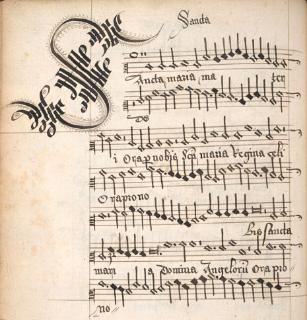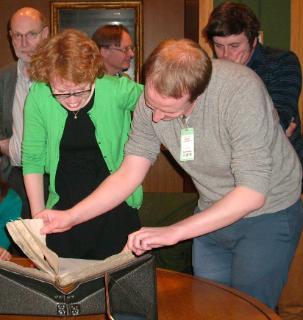News Archive
Exploring Henrician Partbooks at the British Library
On 12 May a multidisciplinary group of scholars gather to explore and re-examine some the British Library's musical partbooks from the reign of Henry VIII. Experts introduced the sources and initiated discussion, while manuscripts were available for participants to have a look at.
David Skinner started the day with an introduction to Harley 1709, a single surviving partbook from a set containing 26 votive antiphons. Little is known about the origins of the book, which is normally dated to the mid-1520s, though the otherwise unknown composer Thomas Hyllary might provide a clue. Tudor Partbooks PhD student Daisy Gibbs has found records of a Thomas Hyllary from the West Country in the right period. Although the composers of the majority of the music - including Nicholas Ludford, Robert Fayrfax, Richard Davy and William Cornysh- and the manuscript’s strapwork initials suggest a date of c.1515-20, the inclusion of Thomas Tallis's Salve intemerata presents something of a puzzle and suggests a slightly later dating for the manuscript. Tallis’s birthdate is usually estimated to be c.1505 and Salve intemerata is not his earliest known work (it is more mature than, for example, his Ave Dei patris).

Much discussion followed surrounding Tallis's biography and career. A birthdate of 1505 would make him surprisingly young to have composed such an accomplished piece as Salve intemerata. Was he something of a child prodigy or does our estimated birthdate need revising (making him even older at his known death date in 1585)? Roger Bowers gave an extempore overview of the first knownrecord of Tallis's life in the Dover Priory Account books in 1530/1 suggesting that his role playing the organ and running a choir was a substantial one, not just a job for a talented teenager. This would support a birthdate of c.1500-1505. Further discussion centered around why the music was copied into partbooks (one voice per part) rather than a single large choirbook as was still common at this date, and the extent to which these copies were intended for performance use or were library copies for singers to learn or copy their own parts from.
After lunch John Harper turned our attention to Royal Appendix 45-48, a set of partbooks and an organ book from c.1525 containing Nicholas Ludford's seven Lady Masses. He began with an overview of the liturgical music required to provide the Lady Mass throughout the year and about Ludford's place of employment St Stephen's Chapel, Westminster (with valuable contributions from the St Stephen's Chapel Project). However, the books’ leather bindings stamped with the arms of Henry VIII and Catherine of Aragon, and their appearance in an inventory of the royal library in 1542 (5 years before the dissolution of St Stephen's Chapel in 1547) open up the possibility that the manuscript may have been a gift to the royal family or else had a courtly function. Harper suggest potential uses in the Queen's Chapel, perhaps curtailed by the rise of Anne Boleyn in 1533, explaining the unused appearance of the books and their storage in the royal library by 1542. Another alternative was the King's closet where he held his private devotions, perhaps performed by Philip van Wilder and the Privy Chamber Singers. Yet more possibilities were that the books could have been used by a very small number of singers when the court went on progress, or even by a choir in the household of Princess Mary.
 In the final session of the day John Milsom introduced us to the remains of the earliest English printed set of partbooks, known as the Twenty Songs (1530). The one surviving partbook contains a mixture of love songs, Marian devotional songs, textless pieces and some more surprising items including some lewd songs and others in the voice of prostitutes. Our insight into the printing method was heightened by Peter Blayney whose model of a Tudor printing press helped us to understand the process by which these books would have been made. Several mysteries surround these books. Firstly, they are printed in using the expensive double impression method (where the staves were printed first, and then the music printed over the top), even though the more efficient single impression methods had already been in use in England on single sheet music publication since the 1520s. Secondly, who was the printer and where did they get their music type from? The music type may have been of German origin as it contains natural symbols that were not typically used in English music notation. The highly accurate music type-setting suggest that it was set by a musician and probably an Englishman (due to the different continental and English conventions for the placement of dots after notes).The publisher was possibly John Heywood who had links to the Rastall family whose type was used for the text. Finally, how do we explain both the huge expense outlaid in casting a music fount which was used in only one extant book, and the long gap between this publication and the English printed polyphonic music books in the 1570s? As only one in five printed books from this period survives complete, could this high attrition rate be masking the existence of both earlier and later printed polyphonic music books in early Tudor England?
In the final session of the day John Milsom introduced us to the remains of the earliest English printed set of partbooks, known as the Twenty Songs (1530). The one surviving partbook contains a mixture of love songs, Marian devotional songs, textless pieces and some more surprising items including some lewd songs and others in the voice of prostitutes. Our insight into the printing method was heightened by Peter Blayney whose model of a Tudor printing press helped us to understand the process by which these books would have been made. Several mysteries surround these books. Firstly, they are printed in using the expensive double impression method (where the staves were printed first, and then the music printed over the top), even though the more efficient single impression methods had already been in use in England on single sheet music publication since the 1520s. Secondly, who was the printer and where did they get their music type from? The music type may have been of German origin as it contains natural symbols that were not typically used in English music notation. The highly accurate music type-setting suggest that it was set by a musician and probably an Englishman (due to the different continental and English conventions for the placement of dots after notes).The publisher was possibly John Heywood who had links to the Rastall family whose type was used for the text. Finally, how do we explain both the huge expense outlaid in casting a music fount which was used in only one extant book, and the long gap between this publication and the English printed polyphonic music books in the 1570s? As only one in five printed books from this period survives complete, could this high attrition rate be masking the existence of both earlier and later printed polyphonic music books in early Tudor England?
It is difficult to capture to the range of discussion that took place throughout the day both formally during the session and informally as we circulated and viewed the various manuscripts and printed books. Inevitably these discussions raised as many questions as they answered, but the study day has opened up many new avenues for consideration and further research. Our next study day will be held at Christ Church, Oxford, on 19 November and will focus upon the interaction of manuscript and printed music as exemplified by the Baldwin partbooks, GB-Och: Mus. 979-983.
Last modified: Sat, 17 Oct 2015 11:10:35 BST


